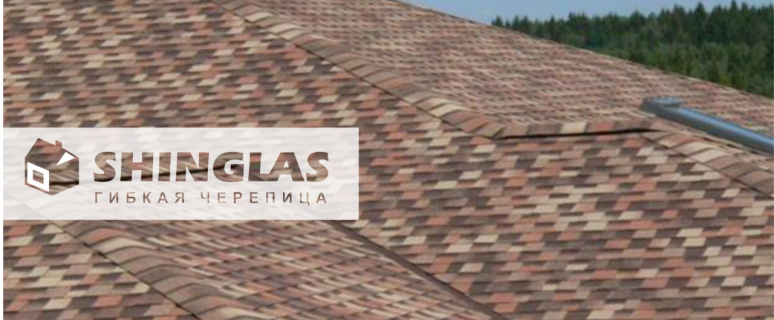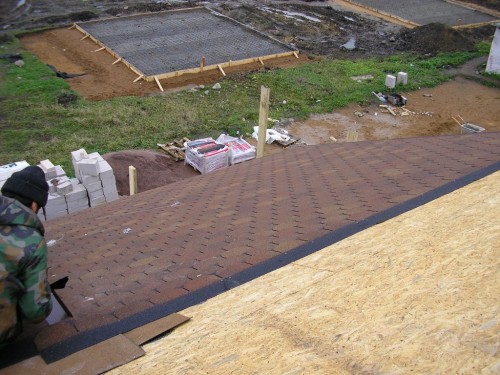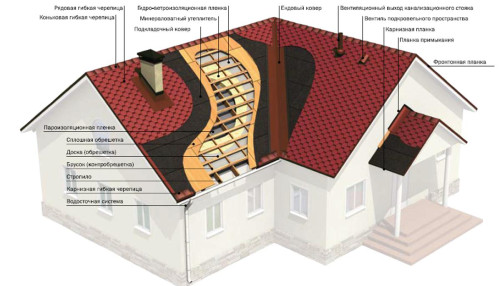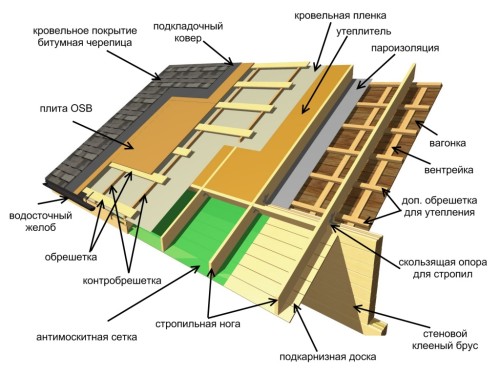
Flexible tile Shinglas: characteristics, installation, reviews Building materials

The roof in the house is one of the key elements. And the tile is one of the best options due to high-quality coverage and attractive design. Now you will learn that Schinglas Tiles and why it is the leader among other tile species.
Content
Features of flexible tile
Shinglace's flexible tile is a combination of security, beauty, practicality and ease of installation. One of the main advantages is the development, taking into account all the peculiarities of our climatic zone. And this means that the tile without problems can be transferred both high temperatures in the summer and severe frosts in the winter season. In addition, it provides good thermo- and waterproofing.
The basis of the composition of such tiles is basalt granulate. It is able to fully protect the material from serious damage and the influence of many external stimuli.
Montage tiles Shinglas
Laying the tiles is the process is quite time consuming and requiring care and responsibility. But when working with Roofing Schinglas, there are a number of additional requirements and stages when installing, which must be considered:
- The process of installing a soft roof should always comply with the following requirements:
- the main requirement for the foundation is evenness and sustainability. It should also bend without any problems;
- for the desired effect, it is necessary to use a calibrated board, moisture-resistant faeer or OSB-3 slab;
- it is impossible to admit even minimal gaps. If any, it will be necessary to carefully polish the surface after installing flooring on the skates;
- the thickness of the material is selected depending on the steps of the installed rafters.
Important! Before installing boards, they must be carefully treated with antiseptic and antipiren. If your roof has old boards, it is best to throw and replace them with new ones.
- Ventzor. If the ventilation of the attic or the attic will be insufficient, the microclimate in them can be very violated. Provide a steadily good microclimate can only if there is a hole for the passage of fresh air, the heat insulation channel, the hole for the exhaust.
You can use PVC siding to binder cornices. The ventilation function in this case will perform a sophisticated bar. If the eaves you will draw out with a clapboard, there will be small gaps between the planks.
- Piercing carpet. It should be stray from below. The longitudinal beet should be 15 cm, and transverse - 10. Each seam is needed to sneak with mastic or glue.
- Installation of slats:
- all metal strips must be mounted by an edge from above;
- mounting them should be zigzag. At the same time, the fasteners step must be at least ten centimeters. For the same technique, both front stripes are attached;
- the end carpet is also attached using mastic or glue. It is important not to forget to nail it from top of the nails for greater strength. The step is 20-25 centimeters;
- nails need to be knitting around the perimeter and not to leave empty areas.
- To close all IHDDs, you can use one of three options:
- trimmed;
- weave;
- technique of open endanda.
Mandatory element when installing flexible tile - a consumer holder. It provides smooth and uniform convergence of snow mass from the roof.
If you only build a roof
It is difficult to say that it is more difficult - putting the tile on the finished roof or one that you only build. And if the second option is relevant for you, you will have to follow the work plan so that everything is fulfilled correctly:
- The first thing is the construction and strengthening of the rafter structures and the installation of vapor barrier. It will not focus on these stages, and we turn to the installation of flexible tiles to the right roof.
- Scissors on metal Cut the bar of the front-bottom sink. Thus, it will be tightly adjacent to the rope bar.
- Planks on the skate are also cut.
- On top of the planks put the shinglas tiles itself. It must be navigated with nails with a step of retreat from the edge of 2.5 cm. Always use galvanized nails. After that, you can install a drainage system or an abnormal sink. But this is at your discretion.
- The back of the tile should be sure to smear the mastic. Watch not to miss a single site.
- Now you can lay downs. At the same time, you need to rejuvenate the protective film, and only after that start laying.
- The first row of tiles is best laying from the middle of the roof slide. Watch that the whole range is parallel to the skate-cornice tile. When you hit the tile of nails, make sure that they do not dive into it, and remained at the same level.
- The second row is stuck also from the middle and on the parties on the same principle.
- Further layers can be put, focusing on the thread that you need to tighten on the skate and make marking chalk.
- At the edges of the shonts will always be an excess tile. It can be cut off by a regular stationery knife.
- For additional protection from the rain, the roof on the edges of the roof also recommend to cover with mastic from the back. The width of the coating should be at least ten centimeters.
- Ventilation passage also need to be lubricated with mastic for better waterproofing.
- On the slopes after installing the whole tile, you can install a ski aerator, and on top of it - skate-carnice tile.
Additional installation tips and specific technological features
It is very important before the start of work is to determine the required number of tiles, as well as where the symborate system will be located.
We provide you with instructions with technological aspects of installation, list of tools and materials:
- if the angle of inclination of your roof becomes more than 60 degrees, you will have to apply to the tile of mastic;
- in order for the roof material more tightly and was not dependent on the corner of the roof, it must be fixed with roofing nails with a wide hat;
- plates to the ground to be signed the most convenient for all with a wide hammer or thyroid.
- for cutting tiles, you need a sharp and strong knife. But when you work with him, remember the need to use the board, which will protect the roofing carpet from damage during operation;
It should be noted that the flexible tile of Shinglas - the material is quite fatty, and you will not have any special problems in the work. A positive property is the possibility of mounting such a tile almost on any roof, regardless of the type and complexity of the design.
Even before you put a laying tile, you need:
- On the dry board to execute the crate. If possible, we advise you to use moisture-resistant OSP.
- The gasket carpet needs to be laid in such a way that it completely covered all the roof. Do not allow some sites open. The slope of the roof should not exceed 1: 3, and the slope is less than 30%.
- From the petal you need to cut the tile and install it. She can perform a good alternative skate.
- When the installation is finished, the tile must be processed.
- If insufficient ventilation, you will have to make an additional vent. The optimal option is the installation of a vacuum fan.
The price of a flexible tile Shinglas is slightly higher than standard, but if you go into details, you really save well. It is better than cheap analogs, durable, does not fade over time and completely eco-friendly. We believe, you will agree that it is better to overpay once and in one approach to do all the work than a couple of years old to do everything again and spend money again.
His price tile fully justifies. And if you still doubt the choice, pay attention to additional benefits:
- shinglace flexible tile will not need painting;
- time account until it supports a pleasant aesthetic species goes for decades;
- even in the coldest winter or hot summer tile not only to keep well, but also will provide high-quality thermal insulation of your attic or an attic.
No vain reviews about Shingle Shinglace exceptionally positive. Both professional builders and newbies. It is really easy to install and reliably. Therefore, we advise you to make the right choice, protecting yourself from a number of problems that appear when laying cheap tiles.
New comments
Add a comment
To send a comment you need authorize.























Good tile
I would still not like it, it is cheaper, and in quality is not worse than imported. It is not clear the expression in the article that it is more expensive? Standard is what? If there is a form of the Finca, then she, in my opinion, they have the cheapest, put 10 years ago, until now, at least where it was overlooked, lies like a monolith.
It may be due to the standard roof - metal tile, compared to it can be more expensive due to the preparation of the base. But again, the cost of the complexity of the roof depends, if the roof is complex, then the advantage in the cost will be at bitum.
Of course, it is much easier with bitumen, waste after laying at least after mounting a metal tire roof sometimes waste reach 40%, so that the entire savings eats.